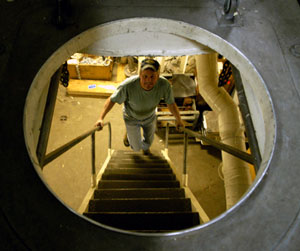 |
Daily Update
Calendar
Dispatch 16 - September 25, 2003
By C. A. Linder
Weather conditions: Overcast skies, calm winds and seas,
air temperature 28°F
Mooring Marathon
I don't think I have ever seen Bob Pickart happier. The WHOI mooring
crew brought four more moorings safely on deck today, taking advantage
of the ice-free, calm open water. To
top it off, all of the instruments that we have downloaded data from
so far were carrying a full load of 14 months of oceanographic data!
There is always an element of risk with moorings. The ocean is a very
hostile environment - moorings can become dislodged and drift away,
they can fail to release, or the instruments can just simply not work.
The entire science crew is ecstatic - data of this kind has never
before been collected in the Arctic Ocean. What's so special about
this mooring data? The spacing of the instruments, in the form of
a picket fence
across the shelfbreak, allows us to see a cross-section of the
temperature, salinity, and currents of this part of the Beaufort Sea
over the entire year. Sarah Zimmermann worked for 20 hours straight
yesterday checking over the moored profiler CTD data. Dan Torres has
been working nonstop today extracting the
current data from the moored ADCPs.
I asked Bob how long it would take to analyze all of this data. He
replied: "at least five years."
I have received several questions from Mrs. Werner's 6th grade
class at the Morse Pond School.
Question: How thick is some of the ice on this trip
compared with last year?
Answer: Last year the ice was dense, but broken into
small chunks. This condition is known as "brash ice." Check
out this photo
of John Kemp and Dan Torres deploying a WHOI mooring last year. This
year, we haven't seen a single chunk of ice since our CTD work in
the northern Chukchi Sea. This is mostly a function of the time of
year. Last year's deployment cruise on the Polar Star took
place in July and August. At that point, the ice in the Chukchi Sea
and southern Beaufort Sea was melting and breaking up, but hadn't
completely melted away. This September, the annual ice has melted
back as far as it will go... It's only a matter of time before new
annual ice starts forming, since this process begins in October. The
ice edge creeps back, slowly covering the Western Arctic with a layer
of new annual ice. Earlier in the cruise, when we did see ice,
it was similar to what we encountered last year - broken chunks floating
in loose congregations. We have done very little ice breaking this
year - mostly just "ice pushing!"
Question: What has been the most interesting finding
on this trip so far?
Answer: WHOI Principal Investigator Bob Pickart is
elated by the performance of his moored instruments. This quote helps
put it in perspective: "We have just looked at the data from
one of the coastal moored profilers. This one instrument performed
four CTD casts per day for 14 months... That's 1,600 CTD casts! In
comparison, here we are on the Healy on CTD cast number 121."
This question comes from David, who's in 4th
grade at the Mullen Hall School in Falmouth,
Massachusetts.
Question: If the wind was heading north through the
eastern hemisphere over the north pole into the western hemiphere,
once it passed the north pole would it be heading southwest? P.S.
If you are standing on the north pole, how do you describe the direction
of the wind?
Answer: Hi David, good question! Winds are always
named by the direction that they originate from. So, you would call
that northbound wind a "southerly." As the wind crosses
the pole, it automatically becomes a "northerly" since it
is coming from the north. By that convention, if you're standing directly
at the north pole, any wind you feel would be a "southerly"
since the only direction you can go from the pole is south!
 |
 |
| John Kemp climbs out of a storage hold deep in the bowels of the ship. |
| Click
to enlarge |
Tonight the CTD watchstanders, led by CTD expert
Marshall Swartz, will be testing the
CTD sensors that will be redeployed on the moored profilers. Carin
Ashjian will also do another net tow at 4AM, so we'll see if she finds
some more copepods. Tomorrow we will recover the last two WHOI moorings
and Lisa Munger's Acoustic Recording Package (ARP).
If you have a question about Arctic oceanography, shipboard life,
or what we had for lunch on the Healy, send your question
to arcticedge@whoi.edu. I'll
do my best to find the answer and post it in a dispatch.
 Previous
Dispatch Next Dispatch Previous
Dispatch Next Dispatch

Back to
Calendar
|




